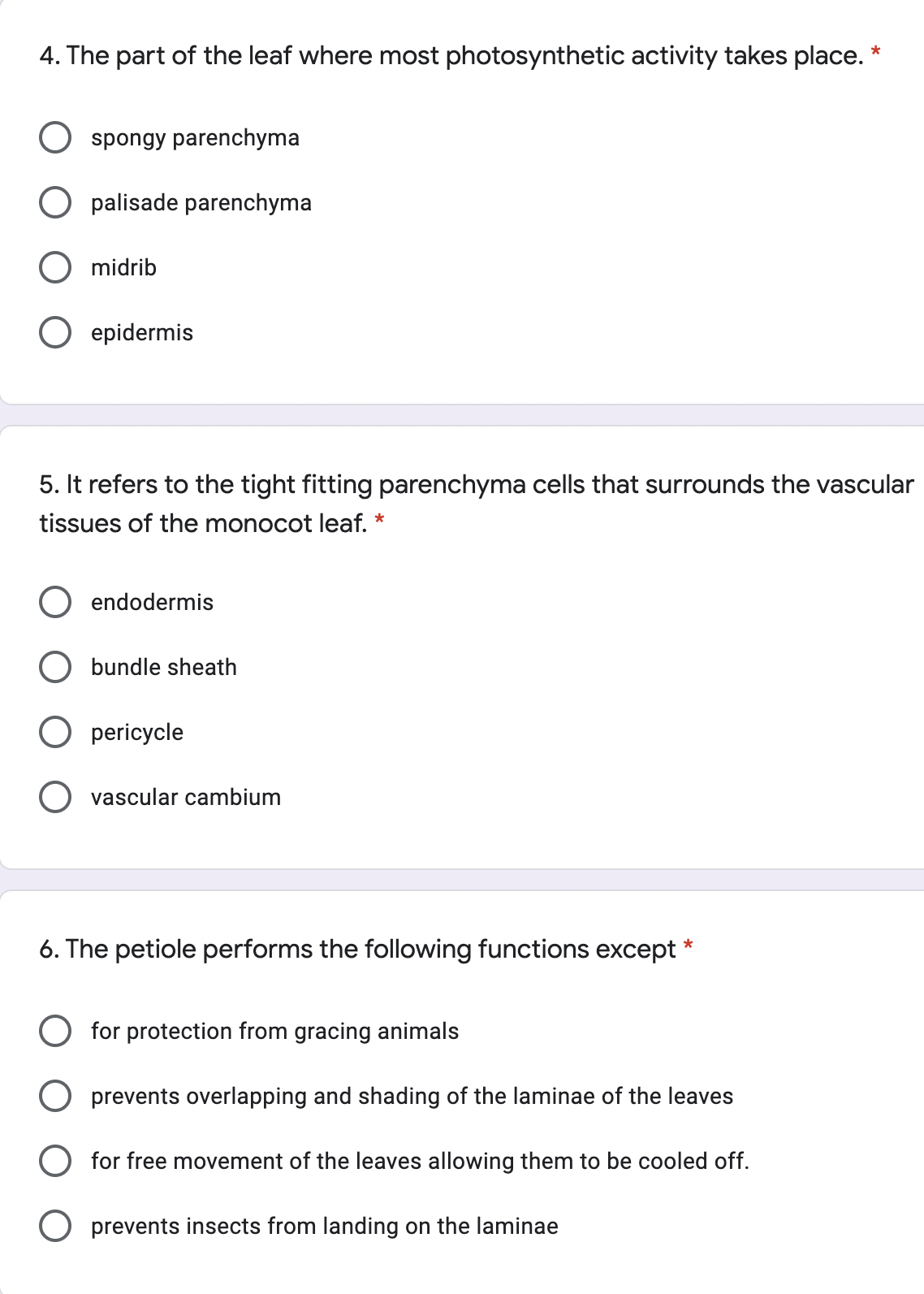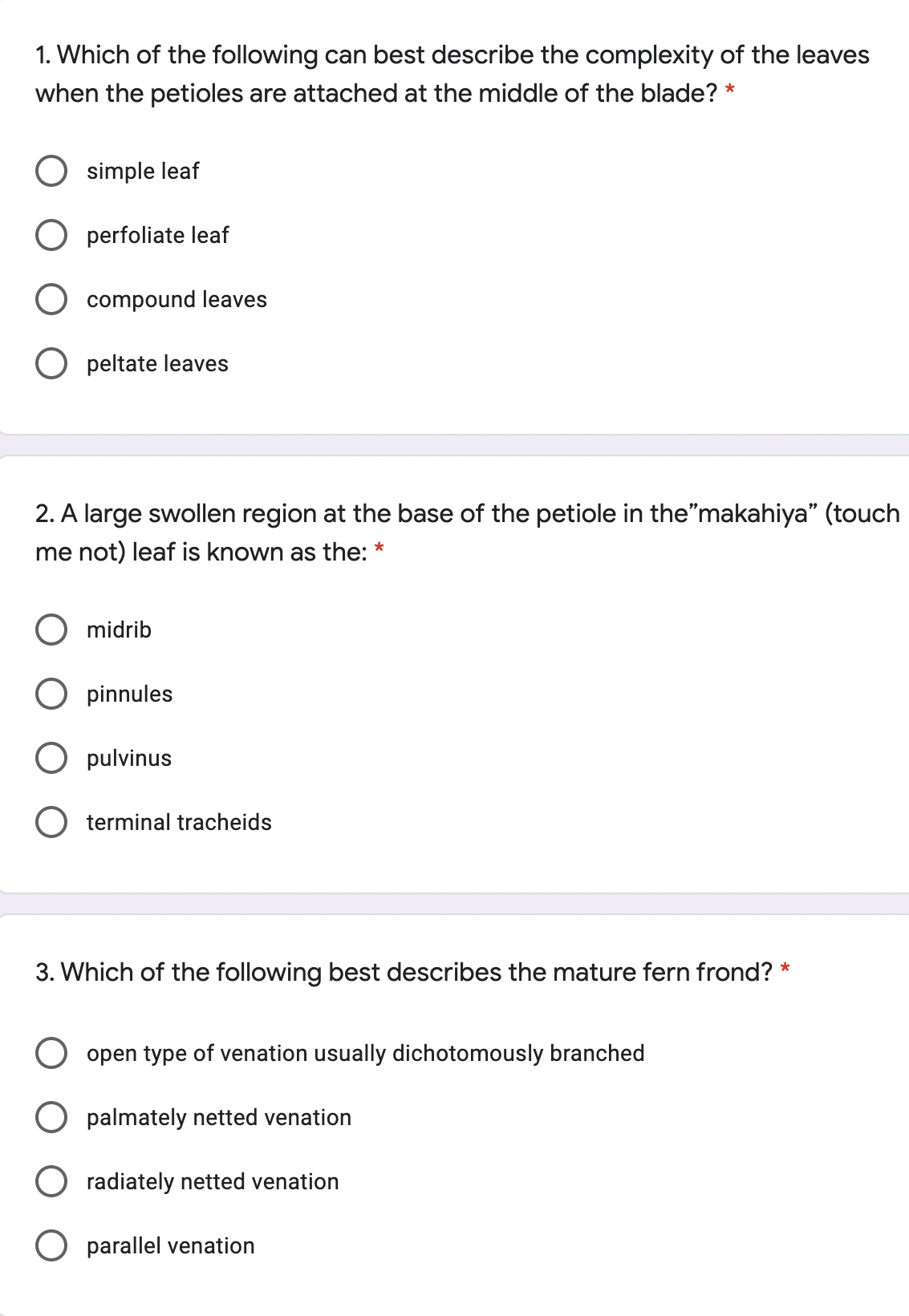Biology: The Dynamic Science (MindTap Course List)
4th Edition
ISBN:9781305389892
Author:Peter J. Russell, Paul E. Hertz, Beverly McMillan
Publisher:Peter J. Russell, Paul E. Hertz, Beverly McMillan
Chapter34: Transport In Plants
Section: Chapter Questions
Problem 7TYK
Related questions
Question
Instructions: MULTIPLE CHOICE
Only choose the correct answer from questions 1 to 6 and no need for an explanation.

Transcribed Image Text:4. The part of the leaf where most photosynthetic activity takes place. *
spongy parenchyma
palisade parenchyma
midrib
epidermis
5. It refers to the tight fitting parenchyma cells that surrounds the vascular
tissues of the monocot leaf. *
endodermis
bundle sheath
O pericycle
O vascular cambium
6. The petiole performs the following functions except
*
for protection from gracing animals
prevents overlapping and shading of the laminae of the leaves
for free movement of the leaves allowing them to be cooled off.
prevents insects from landing on the laminae

Transcribed Image Text:1. Which of the following can best describe the complexity of the leaves
when the petioles are attached at the middle of the blade? *
O simple leaf
O perfoliate leaf
O compound leaves
O peltate leaves
2. A large swollen region at the base of the petiole in the"makahiya" (touch
me not) leaf is known as the: *
O midrib
O pinnules
pulvinus
terminal tracheids
3. Which of the following best describes the mature fern frond? *
O open type of venation usually dichotomously branched
palmately netted venation
radiately netted venation
O parallel venation
Expert Solution
This question has been solved!
Explore an expertly crafted, step-by-step solution for a thorough understanding of key concepts.
Step by step
Solved in 3 steps

Knowledge Booster
Learn more about
Need a deep-dive on the concept behind this application? Look no further. Learn more about this topic, biology and related others by exploring similar questions and additional content below.Recommended textbooks for you

Biology: The Dynamic Science (MindTap Course List)
Biology
ISBN:
9781305389892
Author:
Peter J. Russell, Paul E. Hertz, Beverly McMillan
Publisher:
Cengage Learning

Biology: The Unity and Diversity of Life (MindTap…
Biology
ISBN:
9781305073951
Author:
Cecie Starr, Ralph Taggart, Christine Evers, Lisa Starr
Publisher:
Cengage Learning

Biology: The Unity and Diversity of Life (MindTap…
Biology
ISBN:
9781337408332
Author:
Cecie Starr, Ralph Taggart, Christine Evers, Lisa Starr
Publisher:
Cengage Learning

Biology: The Dynamic Science (MindTap Course List)
Biology
ISBN:
9781305389892
Author:
Peter J. Russell, Paul E. Hertz, Beverly McMillan
Publisher:
Cengage Learning

Biology: The Unity and Diversity of Life (MindTap…
Biology
ISBN:
9781305073951
Author:
Cecie Starr, Ralph Taggart, Christine Evers, Lisa Starr
Publisher:
Cengage Learning

Biology: The Unity and Diversity of Life (MindTap…
Biology
ISBN:
9781337408332
Author:
Cecie Starr, Ralph Taggart, Christine Evers, Lisa Starr
Publisher:
Cengage Learning


Biology 2e
Biology
ISBN:
9781947172517
Author:
Matthew Douglas, Jung Choi, Mary Ann Clark
Publisher:
OpenStax